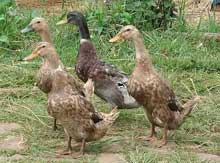H5N1 virus may persist on feathers fallen from domestic ducks

Highly pathogenic avian influenza virus (H5N1) may persist on feathers fallen from the bodies of infected domestic ducks and contribute to environmental contamination.
Researchers from the National Institute of Animal Health, Tsukuba, Ibaraki, Japan report their findings in the August 2010 issue of the journal Applied and Environmental Microbiology.
Since the emergence of Asian avian influenza virus in 1997, it has spread to Europe, the Middle East and Africa causing significant mortality and economic loss in the poultry industry. Although the virus is mainly found in waterfowl and transmitted through faecal contamination in water, humans as well as other mammalian species have contracted the virus through close contact with infected birds.
A prior study showed that H5N1 could replicate in the skin cells of feathers and further suggested that those that drop off the body could potentially contaminate the environment. Here, researchers evaluated the environmental risk posed by contaminated feathers by inoculating domestic ducks with H5N1, collecting feathers, faeces and drinking water three days following, and then storing them at 39 degrees and 68 degrees Fahrenheit for 360 days. Results showed that H5N1 persisted the longest in feathers at both temperatures.
“These results indicate that feathers detached from domestic ducks infected with highly pathogenic avian influenza virus (H5N1) can be a source of environmental contamination and may function as fomites with high viral loads in the environment,” say the researchers.













